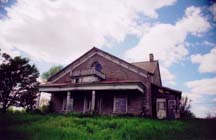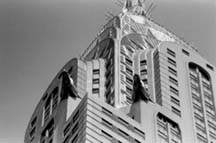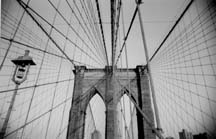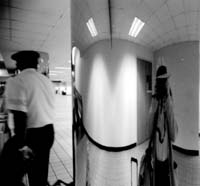Thanksgiving. The unmerciful lineup at the bus terminal to go home. The line for tickets snakes back and forth between red ribbons seven times before heading straight through the terminal toward the far windows. Of the ten wickets, only five are open. For twenty minutes I wait, shifting forward at irregular intervals, finally purchasing my ticket with two minutes to spare before departure. The lineup for the bus extends past the lineup area, across the bus lane, along the far wall and almost out of the terminal altogether.
It’s the first major holiday of the fall season, a long weekend, the first visit home for students away from home for the first time and the traffic is insane. The driver of this bus (the second put on the route) tries to make up for lost time by steering in and out and around slower traffic. I’ve chosen a seat next to a reader because I don’t feel like talking to a stranger today, pull out my own book and continue from where I left off, occasionally looking up to notice the leaves outside have begun to turn orange.
Before the bus pulls in, I see my Dad waiting for me, looking slightly confused that I haven’t been on any of the buses which have arrived so far, spewing passengers and diesel fumes. We return to Mum and Dad’s to find my sister and family have arrived now too. Not everyone could make it this year, but a good showing nevertheless.
Several of us continue out to the cottage to close it up for the season – a very southern Ontario thing to do. And as I’m looking across to the island, its trees in full autumn colours, my sister informs me that it’s been sold to developers. Other developers have tried to encroach on this quiet place before and none of their projects have actually come to fruition, but one of these days they will. Already this place is not the place it was when I was a child; the lake, the cottage, the trees, are not the same. People have died, cottages have changed hands and, inevitably, they will continue to do so.
Back in town, we watch a movie, a comedy we all enjoy (a pretty amazing feat considering a range in ages from eight to eighty-seven) – If It’s Tuesday, This Must Be Belgium. My sister tries to get the kids to settle down for the night. She turns on the stern mother act to get their attention; funny how her words sound so familiar. Then she turns away, smiling at me, at the joke we both tacitly understand.
In the morning, we begin preparations for Thanksgiving dinner. It’s a communal affair, several of us pitching in to make the meal. I was the one who suggested 2 p.m. for dinnertime. Why? Because that’s when Mum has always served holiday dinners. And now that the kids are passed hungry, I remember being passed hungry too and never understanding why 2 p.m. was imposed for these big family meals. The kids get a snack and dinner keeps roasting.
Mum, my sister and I go through tablecloths and china, the suggestion being that the history of each item should be documented on paper while there’s still someone to recall it. Dad suggests that Mum could give some of the items to the children now, my Mother reticent to part with them, my sister and I agreeing. Things happen in their own time.
With a final flurry of activity, the meal is served. The kids clean their plates before we’ve said grace (something I wouldn’t have been allowed to get away with). I’ve always considered us to be a pretty non-religious family (in the formal sense); consider myself strictly non-denominational. But it seems appropriate to say grace when we’re together, especially at Thanksgiving. It’s a “May the Circle Be Unbroken” moment.
Thanksgiving is one of the few (if not the only) holiday that I find myself drawn to, that I feel disappointed if I don’t acknowledge. Maybe it’s the pagan in me, but it seems so appropriate to acknowledge and celebrate the bounty of the growing season. I try to explain this to my niece, but she doesn’t get it; I didn’t at her age either.
Mum used to tell me to count my blessings and I always thought it was a daft thing to do. Despite a pretty privileged upbringing, I always had a knack for seeing the negatives (although for some reason many people seem to think I’m a very optimistic person

 Why would I consider such an odd juxtaposition? Because those were the two places my reading tour took me in June (as well as home in Toronto, of course).
Why would I consider such an odd juxtaposition? Because those were the two places my reading tour took me in June (as well as home in Toronto, of course). its second-storey porch. Among Picton’s other buildings of note is the Regent Theatre, housed in a building also dating to the 1830s. After renovations, it reopened in 1922 as an Edwardian-style opera house with 900 seats. It still operates as a venue for both live theatre and movies, although the number of seats has (fortunately) been halved.
its second-storey porch. Among Picton’s other buildings of note is the Regent Theatre, housed in a building also dating to the 1830s. After renovations, it reopened in 1922 as an Edwardian-style opera house with 900 seats. It still operates as a venue for both live theatre and movies, although the number of seats has (fortunately) been halved. Less than a week later, I was on the (mostly empty) train heading to New York. The train runs down the Hudson River valley, crossing and uncrossing the river and running along its bank with the wild white and purple phlox. After sunset, after the long dark ride through the under-river tunnel, I emerged suddenly somehow in the city.
Less than a week later, I was on the (mostly empty) train heading to New York. The train runs down the Hudson River valley, crossing and uncrossing the river and running along its bank with the wild white and purple phlox. After sunset, after the long dark ride through the under-river tunnel, I emerged suddenly somehow in the city. stomach feeling. Makeshift memorials have sprung up in sometimes unexpected places all over lower Manhattan. Three subway stops remain closed and a surprisingly large number of blocks are still cordoned off nine months later. Even being right there, I found it difficult to comprehend the magnitude of this event; not much wonder New Yorkers are still struggling with it. I stopped for a rest by the Hudson and noticed I was the only one bothering to look up when the helicopters trailed by every few minutes, and wondered if I was the only one noticing, even now, the occasional waft of burnt in the air.
stomach feeling. Makeshift memorials have sprung up in sometimes unexpected places all over lower Manhattan. Three subway stops remain closed and a surprisingly large number of blocks are still cordoned off nine months later. Even being right there, I found it difficult to comprehend the magnitude of this event; not much wonder New Yorkers are still struggling with it. I stopped for a rest by the Hudson and noticed I was the only one bothering to look up when the helicopters trailed by every few minutes, and wondered if I was the only one noticing, even now, the occasional waft of burnt in the air. The next day I treated myself to a browse through the Metropolitan Museum of Art. I walked through the Modern and Annenberg Impressionist collections, an overwhelming assortment of Degas, Cézanne, Sisley, Caillebotte, Chagall, Monet, Manet, Van Gogh, Seurat, Picasso, Lautrec and a few others. I noticed not all the Van Gogh’s had been hung in the same room; if they were, they’d probably spontaneously ignite from the sheer intensity of energy and vibrancy of colour. They hadn’t mounted all the Monet’s in the same room either; his work glows in such a fluid way that viewers would be lulled into a complete state of calm and they’d never leave.
The next day I treated myself to a browse through the Metropolitan Museum of Art. I walked through the Modern and Annenberg Impressionist collections, an overwhelming assortment of Degas, Cézanne, Sisley, Caillebotte, Chagall, Monet, Manet, Van Gogh, Seurat, Picasso, Lautrec and a few others. I noticed not all the Van Gogh’s had been hung in the same room; if they were, they’d probably spontaneously ignite from the sheer intensity of energy and vibrancy of colour. They hadn’t mounted all the Monet’s in the same room either; his work glows in such a fluid way that viewers would be lulled into a complete state of calm and they’d never leave. and The Poets House. Went to the Upper West Side for brunch and a look around, wandered the Village and Central Park some more. With Marianne Faithful hoarse in my ear, I took a walk around Times Square at night. This city just doesn’t stop. The New York Central Library and the Met alone would take two lifetimes to explore. Manhattan has done a lot of things right and it was a real joy to be there.
and The Poets House. Went to the Upper West Side for brunch and a look around, wandered the Village and Central Park some more. With Marianne Faithful hoarse in my ear, I took a walk around Times Square at night. This city just doesn’t stop. The New York Central Library and the Met alone would take two lifetimes to explore. Manhattan has done a lot of things right and it was a real joy to be there. maple syrup (which is sealed until the next time I make waffles). I think the store of comfort food has helped make up for the mild exhaustion.
maple syrup (which is sealed until the next time I make waffles). I think the store of comfort food has helped make up for the mild exhaustion.